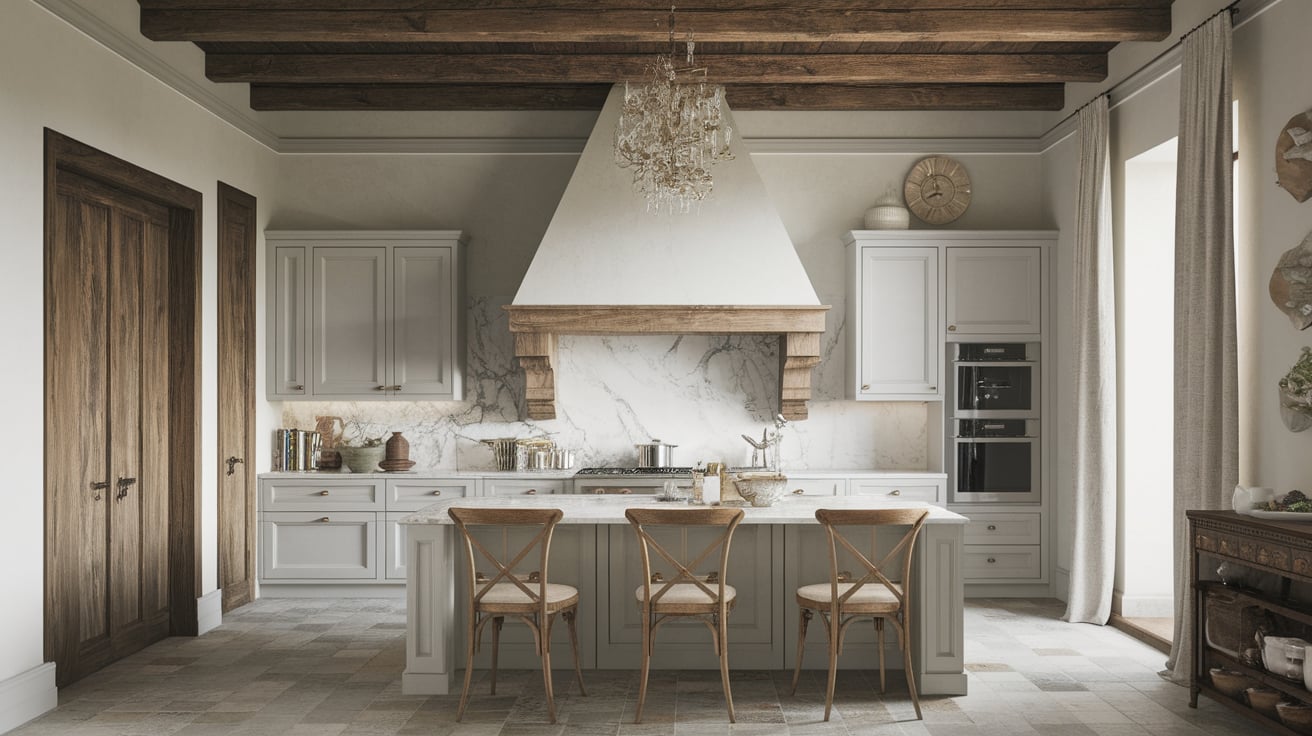Traditional Italian kitchens bring warmth and comfort to any home.
You want a kitchen that feels both useful and beautiful, but finding the right style can be hard. I know how tough it is to blend function with that classic Italian look without going overboard.
I’m here to show you simple ways to create a beautiful Italian kitchen that works for real life.
These tips will help you add authentic touches that make your space special.
In this article, I’ll discuss essential Italian kitchen features, 13 specific looks to try, and practical ways to incorporate these ideas into your own home.
Why Do Italian Families Have Two Kitchens?
In many Italian homes, especially in rural areas, having two kitchens is a common practice. This tradition is deeply rooted in culture, practicality, and family values.
1. The Cucina di Servizio (Service Kitchen)- The secondary kitchen is smaller and more utilitarian, often located in a basement or separate area. It’s used for messy tasks like preserving food or preparing large meals, while the main kitchen stays clean and functional for everyday use.
2. Celebrating Family Meals- Food plays a central role in Italian life, and having two kitchens allows for the preparation of large, communal meals. One kitchen can handle multiple dishes simultaneously, especially during celebrations or family gatherings.
3. Preserving Culinary Traditions- Italian families often pass down recipes and preservation techniques, which can require separate spaces. The secondary kitchen is ideal for tasks like making cheese or curing meats without interfering with the main kitchen.
4. Containing Cooking Smells- Strong cooking odors from garlic, onions, and herbs can fill the home. Having a secondary kitchen helps contain these smells, especially in open-plan homes, making the main kitchen more pleasant for daily use.
5. Practicality and Space Optimization- In larger homes, a second kitchen offers more functional space. It can also serve as a summer kitchen, used during warmer months to prevent overheating the main kitchen.
Key Features of Traditional Italian Kitchens
1. Warm and Inviting Atmosphere
Italian kitchens stand out for their cozy feel. The use of rich, earthy tones creates a welcoming space for everyone. Warm browns, soft yellows, and gentle reds often remind you of the Italian countryside.
Natural materials play a key role, too. Wood, stone, and clay bring texture and depth to the room. These materials age well over time, adding character to your kitchen with each passing year.
Many Italian kitchens use these natural elements in floors, counters, and walls. This creates a space that feels lived-in and comfortable rather than cold or stiff.
2. Focus on Functionality and Comfort
Italian cooking is all about making great food with simple tools. The kitchen design follows this same idea. Everything has a purpose and a place.
The counters offer plenty of room for rolling pasta or kneading bread. Cooking tools are stored within easy reach, and the layout makes cooking flow smoothly from prep to serving.
Yet style isn’t forgotten. Italian kitchens blend good looks with daily use. They’re made for real cooks who want their space to work well and look good while they host friends and family.
3. Integration of Family-Friendly Spaces
The kitchen in Italian homes is the heart of family life. Its open layouts create spaces where family members can talk while meals are being made.
You might see a large table in the middle of the room where kids can do homework while parents cook. Or a small sitting area nearby for guests to chat with the cook.
This setup makes the kitchen more than just a place to make food. It becomes a gathering spot, a homework center, and a social hub. Every inch of space works to bring people together.
13 Classic Looks for a Traditional Italian Kitchen
1. Tuscan-Inspired Warmth
Tuscan kitchens bring the feeling of Italian countryside homes. Clay terracotta tiles add warmth to floors and backsplashes.
Rustic wooden beams and cabinets show natural grain patterns, and stone accents on walls or counters create texture.
These elements combine to form a cozy, sun-baked feeling that makes your kitchen feel like a relaxing Italian farmhouse.
2. Luxury Marble Countertops
Marble countertops bring a classic Italian style to any kitchen. The smooth, cool surface works well for making pasta and pastries.
White Carrara marble with gray veins offers a timeless look. For bolder styles, try darker marbles with striking patterns. Islands topped with thick marble slabs become stunning focal points in your cooking space.
3. Classic Mediterranean Blue and White
Blue and white color schemes bring coastal Italian charm to your kitchen. These fresh colors remind us of clear skies and ocean waters.
Try white cabinets with blue tile backsplashes or accent pieces. Blue and white pottery or dishware makes perfect display items. This color pairing creates a bright, clean feeling that makes even small kitchens feel open and airy.
4. Hand-Painted Ceramics
Hand-painted ceramics add a personal touch to Italian kitchens. Look for tiles with local motifs, such as lemons, olives, or countryside scenes.
Use these as accents on backsplashes or as border details. Display traditional majolica plates on open shelves or walls.
These crafted items bring color and character while showing off skilled workmanship that connects your space to Italian artistic traditions.
5. Wooden Beams and Exposed Ceiling Features
Wooden beams draw the eye upward and add warmth to Italian kitchens. These ceiling features create a farmhouse feel that feels both old and homey.
Dark or honey-toned woods work best for this look. Pair beams with white ceilings for contrast. This ceiling treatment makes rooms feel bigger and adds a touch of rustic charm without taking up any counter space.
6. Arched Doorways and Windows
Arched shapes bring old-world Italian charm to doorways and windows. These soft curves soften the look of straight lines in the kitchen. Consider an arched window above the sink to frame garden views.
Doorway arches create a smooth flow between rooms. Even small arches inside cabinet spaces or over stoves add this classic touch to your kitchen without major construction work.
7. Iron Fixtures and Hardware
Wrought iron pieces add strength and beauty to Italian kitchens. Black iron handles on wooden cabinets create a stark, pleasing contrast. Iron-hanging pot racks keep cooking tools within reach.
Iron light fixtures cast a warm glow across cooking spaces. Even small touches like iron switchplates or hooks bring this classic material into your kitchen design while adding a sense of history.
8. Open Shelving for Displaying Dishware
Open shelves in Italian kitchens give the space a warm, lived-in feel. They show off colorful plates, glasses, and pottery instead of hiding them away.
Wood or iron brackets support thick wooden boards for a rustic look.
White shelves against colored walls make dishes stand out. This style keeps everyday items handy while turning your useful kitchen tools into pretty display objects.
9. Traditional Farmhouse Sink
Farmhouse sinks stand out in Italian kitchens with their deep basins and front panels. These sinks handle big pots with ease while looking beautiful.
White ceramic versions offer a clean, classic look. Stone sinks, with their natural texture, add rustic charm. The wide, open design makes washing and food prep simpler.
This practical fixture becomes a focal point that blends daily use with traditional style.
10. Classic Wooden Cabinetry
Wooden cabinets form the backbone of Italian kitchen design. Choose rich, warm woods like cherry, walnut, or oak. Natural finishes let wood grain patterns show through, adding visual interest.
Many Italian designs feature raised panel doors with subtle details. For a more country feel, look for slightly worn or distressed finishes that make new cabinets look well-loved and full of stories.
11. Copper Cookware and Accents
Copper’s rich, reddish-brown color brings a warm glow to Italian kitchens. Hanging copper pots and pans creates useful storage and wall decor.
This metal heats well for cooking and looks better as it ages. Small copper accents like cabinet knobs or light fixtures add subtle shine. Even a few copper pieces bring a sense of warmth and cooking tradition to your kitchen space.
12. Vintage-Style Appliances
Vintage-style appliances mix old-world charm with modern function. Look for stoves with rounded edges and chunky knobs in cream or pastel colors.
Refrigerators with curved doors and visible hinges add character. These appliances offer today’s features while looking like they belong in traditional settings.
Their unique shapes and colors become statement pieces that stand out among wooden cabinets and natural materials.
13. Fresh Herbs and Natural Elements
Growing herbs brings life, color, and good smells to Italian kitchens. Place small pots of basil, rosemary, and thyme on windowsills for easy cooking access.
Terra cotta planters match traditional decor while keeping plants healthy. For color, add a bowl of lemons or a vase of wildflowers.
These living elements connect your kitchen to nature and Italian cooking traditions.
How to Incorporate Italian Style Into Your Kitchen?
1. Start with a Neutral Base
Creating an Italian kitchen starts with the right background colors. Choose warm, earthy tones for your walls and floors. Soft creams, gentle beiges, and light browns work well as base colors.
These neutral shades help other elements stand out without competing for attention. Natural stone or wood-look floors provide a solid foundation. This calm background lets you add bolder touches that can be changed over time as your taste grows.
2. Choose Key Design Elements to Highlight
Pick one or two Italian features to be the stars of your kitchen. For example, a farmhouse sink can become the center of attention in your space, or you can focus on stunning wooden cabinets with special details.
Your main feature may be a tiled backsplash with hand-painted designs. Limiting your focal points keeps the room from feeling busy or cluttered.
This focused approach also helps control costs when updating your kitchen.
3. Mix and Match Vintage and Modern Pieces
Good Italian kitchens blend old and new for the best of both worlds. Pair a modern fridge with vintage-style lighting fixtures. Use high-tech cooking equipment alongside traditional wooden cutting boards.
New countertops can complement older cabinet styles, creating a kitchen that feels timeless rather than stuck in the past.
It also allows you to keep useful modern tools while enjoying classic Italian looks.
The Influence of Regional Italian Kitchen Styles
-
Northern Italy’s Refined Grace: Northern kitchens feature clean lines, cooler tones like grays and soft blues, and marble accents. They have a polished, formal feel with less ornate detailing and smoother cabinet finishes.
-
Southern Italy’s Rustic Charm: Southern kitchens are vibrant with warm tones like yellows and reds. The style is casual, with textured surfaces, open shelving, and stone or terra cotta accents for a sun-baked, countryside vibe.
-
Sicilian Elements in the Kitchen: Sicilian kitchens are bold, using bright colors like blues and yellows in striking tile patterns. These kitchens also feature mosaic work and darker, rustic wooden items, blending local and exotic influences.
Conclusion
Italian kitchens blend beauty and usefulness in a way few other styles can match. Whether you prefer Northern Italy’s smooth lines or Southern Italy’s bold colors, these designs create spaces where food and family come together.
The best Italian kitchens tell a story through their materials and design choices. Each element, from wooden beams to copper pots, adds to this story while serving a purpose.
You don’t need to change everything at once. Start with neutral colors, then add one special feature like a farmhouse sink or wooden cabinets.
Mix new appliances with traditional touches for a kitchen that works well and looks beautiful.
Italian kitchen design reminds us that cooking spaces should be both useful and full of character, perfect for making meals and memories.























